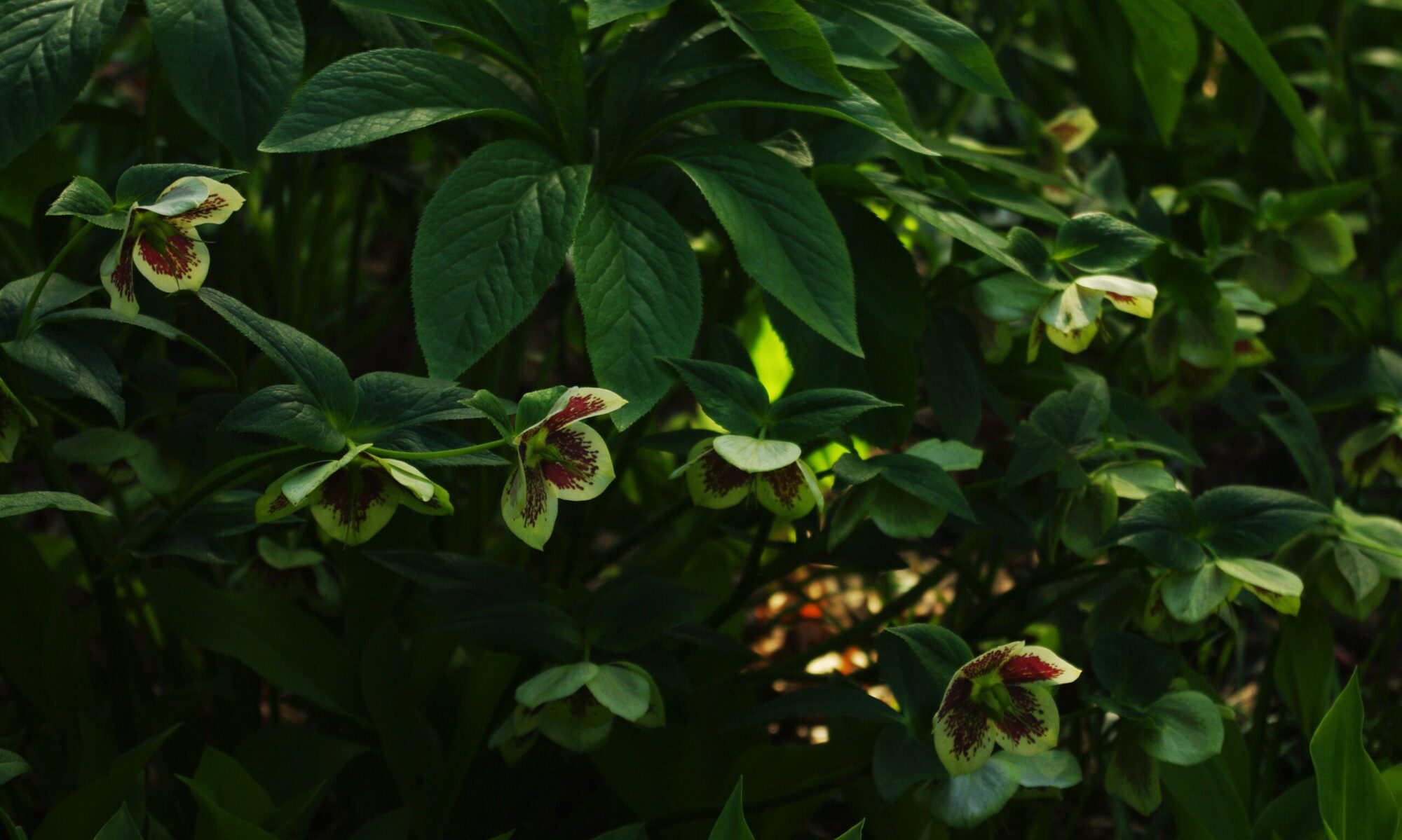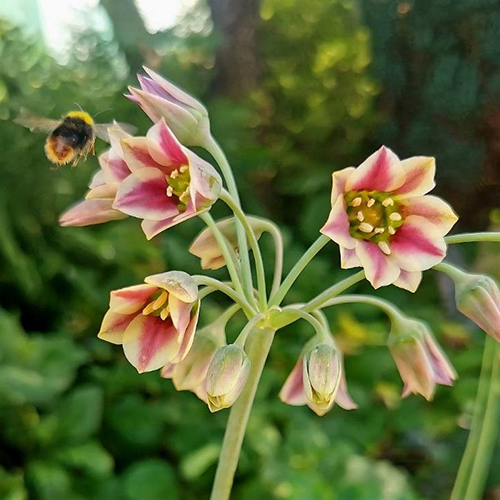
Below is our palette of ornamental alliums which we’re selling this autumn. All of these will be available as bulbs, ready to be planted either in the fall or next spring when the frost has passed.
Alliums (along with narcissus and fritillarias) are in the special group of spring flowering bulbs which are truly deer proof – they all produce compounds that are toxic to deer. Alliums in particular produce organic sulfur compounds which give them their characteristic pungent smell and flavour, and which are toxic. Wondering why we love them so much? Luckily for us, we humans alone – amongst all mammals – have developed digestive enzymes to break these flavourful compounds down into their harmless constituent parts. The alliums we’re selling here are grown and selected for their beauty rather than their flavour – they are all technically edible, but aren’t really worth the trouble or cost compared to their much more nicely flavoured cousins such as the onions and garlics and leeks.
Place an order

1.5″ diameter true blue blooms. Deer resistant. Pollinator Friendly. Fragrant. Butterfly attractor. Rabbit resistant. Good cut flower. Drought Tolerant. 24″ tall.
10 / $5.50
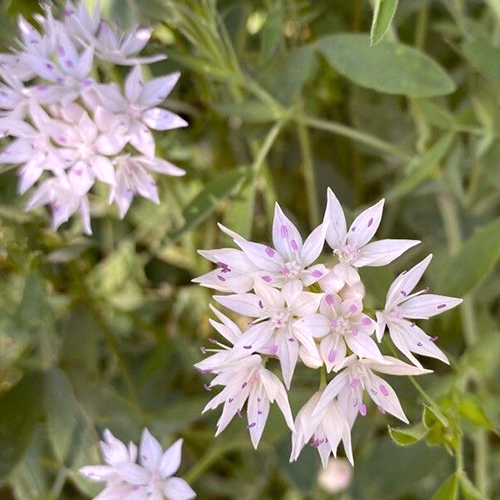
Unique flower form, similar to A. bulgaricum. Bee magnet. 3″ globe of pristine white flowers tinged with pink, which are larger than the typical allium. Fragrant. Deer resistant. Pollinator friendly. Butterfly attractor. Rabbit resistant. Drought tolerant. 16″ tall.
5 / $5.00

Unusual and prized delicate flowers have cream & maroon nodding bells. Fragrant. Deer resistant. Pollinator friendly. Rabbit resistant. Drought tolerant. 24-36″ tall.
5 / $5.50
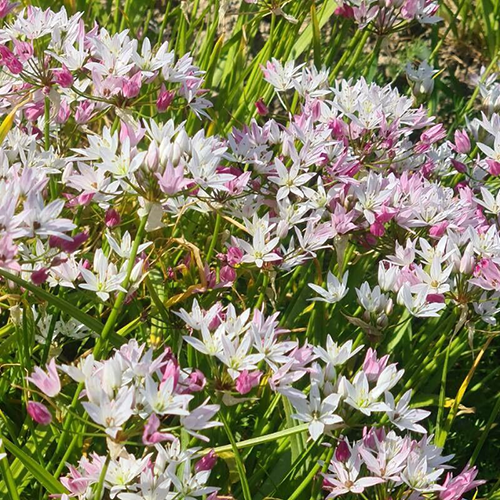
This sweetly scented. attractive allium isn’t content to settle for a single flower color, creating a striking effect by color-changing the round, pinkish clusters of bloom and lightening them to white as time goes on, creating a perfectly-matching mixture of shades. 14”-16”
10 / $6.50

Massive 8″ deep mauve balls of tiny flowers. Fragrant. Deer resistant. Pollinator friendly. Butterfly attractor. Rabbit resistant. Drought tolerant. 48″ (5 feet) tall.
$9.50 ea.

RHS AGM Winner. 6″ bright purple balls that the bees can’t get enough of. Fragrant. Deer resistant. Pollinator friendly. Butterfly attractor. Rabbit resistant. Drought tolerant. 36″ tall.
5 / $5.50
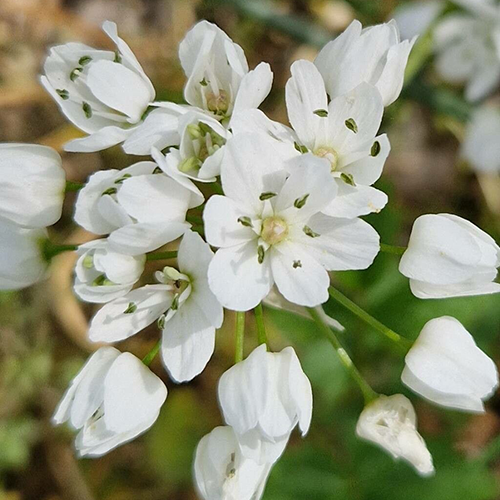
Also known as Naples Garlic, A. neopolitanum is a beautiful, profusely-flowering ornamental onion with sweetly-scented clusters of white, star-shaped flowers forming umbels up to 3-4” wide atop narrow green leaves. Blooming in late spring-early summer, this spectacular allium enjoys long lasting blooms and remains in the garden well into summer. Excellent cut flowers. 10-12”.
20 / $7.00

This award-winning Allium is grown for its unique and attractive display of loose, star-shaped, rose-purple flowers that bloom in giant, spherical umbels, up to 10-12” wide, in late spring-early summer. They rise atop clumps of strap-shaped, blue-green leaves that wither as the flowers begin to bloom. This spectacular Allium enjoys long lasting blooms and remains in the garden well into summer. Seed heads dry after bloom and can be left for ornamental purposes, or picked for flower arrangements. This beauty naturalizes easily, and slowly spreads over time. Both leaves and bulbs exude an onion scent when cut or bruised. 12-24”
3 / $8.50

The Drumstick Allium (Allium sphaerocephalon) is a lovely addition to the early summer garden where it adds interest and movement with its dense, egg-shaped flower heads which delicately turn from green to wine coloured as they mature. Fragrant. Deer resistant. Pollinator friendly. Butterfly attractor. Rabbit resistant. Drought tolerant. 24-30”.
20 / $7.50
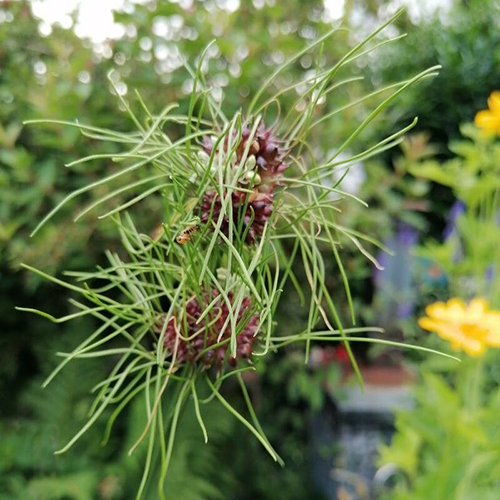
Alliums come in all shapes and sizes and these dramatic blooms with deep plum centers explode with long, lime green hair-like petals, making an impressive statement in the garden, or when cut. With a vase life of 20 days or more, they make excellent and unique fillers in bouquets. 30”.
10 / $6.00
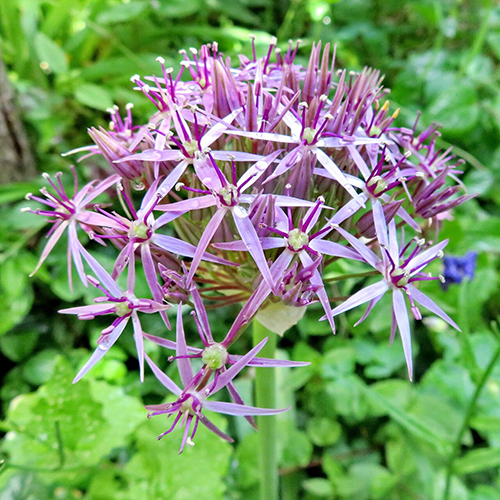
This elegant award winner features star-shaped silvery purple flowers forming a large globe-shaped cluster, 8” wide, atop narrow leaves. Long-lasting blooms keep their beautiful form when dried, looking wonderful in the garden, or in dried bouquets. Excellent cut flower and will naturalize beautifully, coming back year after year. Easily grown in any well-drained soil type in full sun. 16”
5 / $5.50
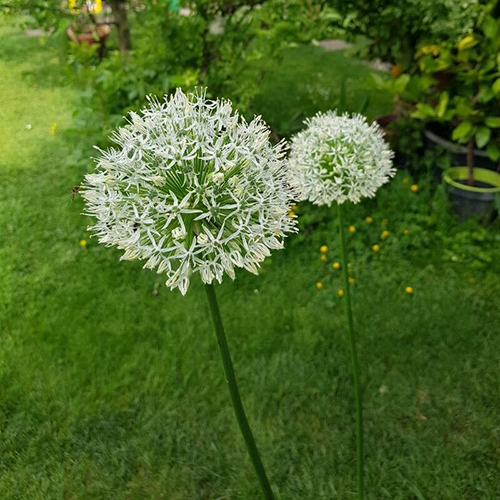
One of the tallest white Alliums, ‘White Giant’ features huge globes, 6-8” wide, densely packed with hundreds of snow-white flowers adorned with emerald green eyes. Borne atop sturdy strong stems in late spring to early summer, this very architectural beauty often keeps its seedheads intact to provide winter interest. 36-48”
3 / $12.00
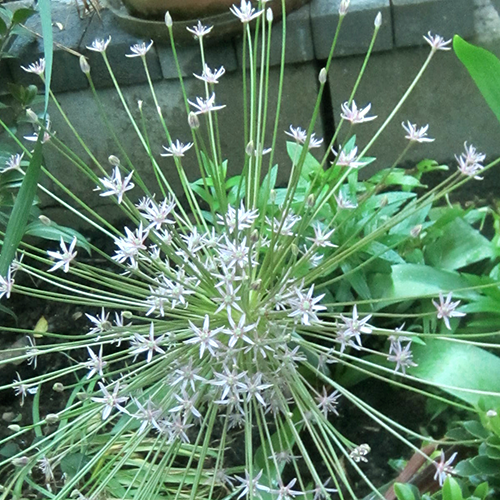
This white version of A. schubertii, has airy, 12”-wide umbels of greenish-ivory buds that open white with green stripes and centers. The bright green stems of unequal lengths give it the look of fireworks. When the seeds ripen, the inflorescence detaches from the stem and rolls through the fields like a tumbleweed thus dispersing the seeds. 12-24”
5 / $8.50
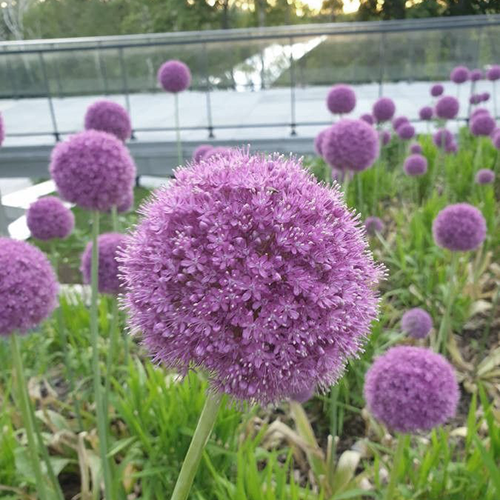
The distinctive clusters of huge lavender spheres up to 8” across bear a striking resemblance to colourful balloons, infusing a sense of whimsical delight into the garden. Sturdy stems and enduring blossoms make this an excellent choice for long-lasting cut flower arrangements. Adding to its allure, and very unusually for an allium, mature bulbs can produce 2-3 globes from a single bulb…truly embodying the spirit of being the life of the party. 24”
$7.50 each
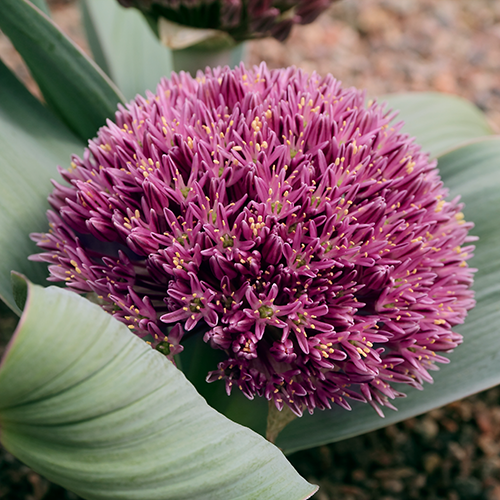
This fabulous and unusual allium boasts extra large, ribbed leaves that create a perfect canvas to show off the enormous (4½”) rose-red flower balls! A short flower stalk keeps the flower tucked away in a charming way, and the long-lasting blooms attract hummingbirds, bees and butterflies. Allium karataviense. 12-14”
5 / $8.50

A well-loved heirloom variety with deep merlot-purple florets adorned with blueberry-purple eyes, create a wonderful pairing of colours. The star shaped florets, packed into a half-globe umbel, 2” wide, on tall, stiff stems, makes a dramatic statement and its bold, upright stature adds structure to the garden. Blooms are an excellent cut flower with a long vase life, and the nectar rich blooms are a pollinator magnet. Early summer blooms, naturalizes readily. 30”
5 / $6.50
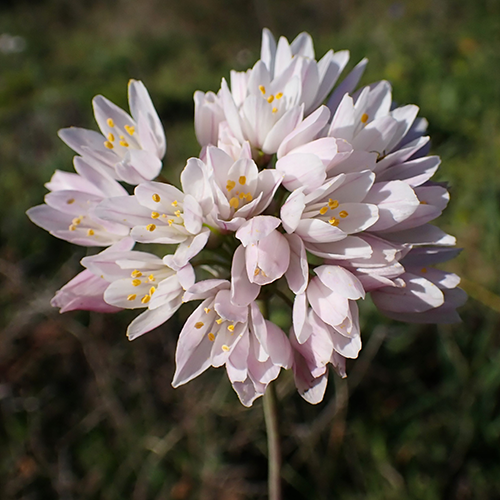
Commonly called rosy garlic, this is an edible, Old World species of wild garlic, native to the Mediterranean region. It’s a beautiful sight with its elegant, exquisitely-scented clusters of pale to rich pink, star-shaped flowers forming umbels up to 3” wide borne atop sturdy stems that rise above long, narrow leaves. Ideal for naturalizing in sunny borders and rock gardens, it thrives in well-drained soil and full sun where it forms bulbils to self propagate. Early summer bloom. 12-18”
20 / $7.50
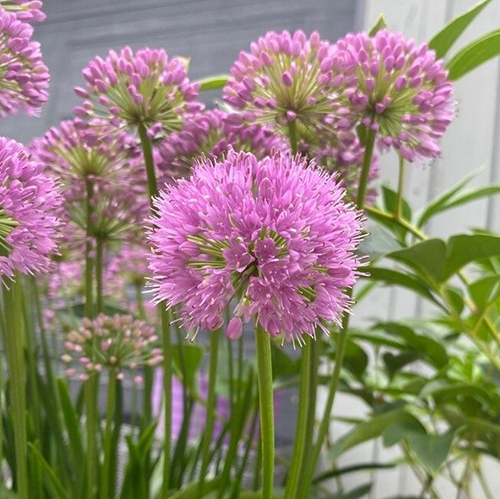
Even among its spectacular contemporaries, this deliciously scented, violet-pink allium paints a very pretty picture in the garden. With large (4”), fluffy spheres of superb substance, each bloom has hundreds of tiny florets that are borne atop straight, sturdy stems strong enough to hold the impressive blooms. Like all alliums, hummingbirds, butterflies and bees all love feeding on the nectar in the fragrant flower heads. Allium carolinianum. 14-16″
5 / $6.50
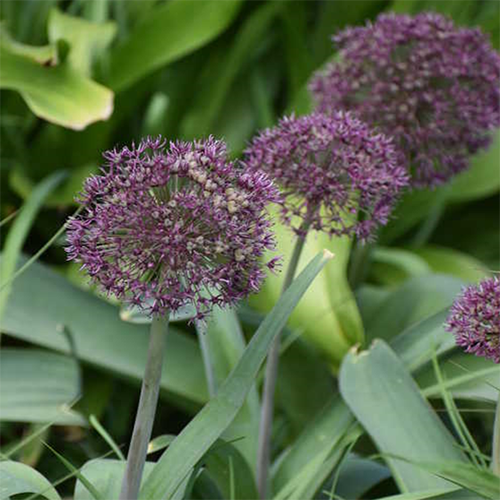
This unique, shorter variety, reaching 12-16″ is perfect for the front of border. Boasting large rounded clusters, 4-6” across that are densely packed with deep purple/red star-shaped blooms that are borne atop straight, sturdy stems just above a clump of broad, fleshy blue-green leaves. Rich in nectar, the flowers attract bees, butterflies and other pollinators. This beautiful early summer bloomer is stunning in cut or dried flower arrangements, and once established, they will naturalize easily. 12-16″
5 / $7.50
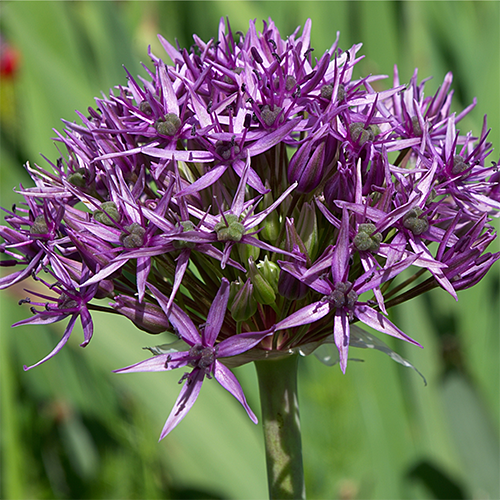
This excellent recent introduction boasts lilac-pink domes of star-shaped florets dotted with green eyes that float atop tall sturdy stems. Alliums are an absolute magnet for pollinators and bloom for weeks in early summer, filling the gap between the spring bulbs and the summer annuals and perennials. 20-28”
5 / $6.50

Striking star-shaped, deep reddish-purple flowers packed into dome-shaped umbels rise on tall, leafless stems and make a dramatic statement in the back of a border. Rich in nectar, the flowers attract bees, butterflies and other pollinators. This beautiful early summer bloomer is stunning in cut or dried flower arrangements, and once established, they will naturalize easily. 32-36”
5 / $6.50

Allium chloranthium. Like cascading fireworks, elegant umbels of sunny yellow and chartreuse florets gently nod to form loose orbs atop straight stems. This delightful fireworks effect is long-lasting and a cheery addition to the late spring garden. Alliums are elegant yet rugged, their colour and interesting flower forms create a garden design with texture and depth. 20-22”
5 / $6.50
